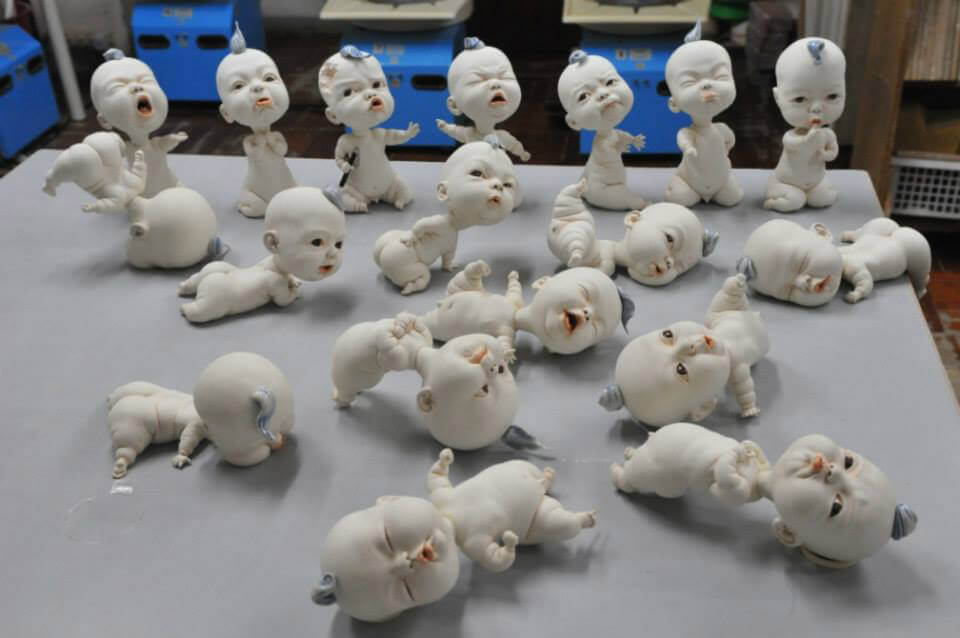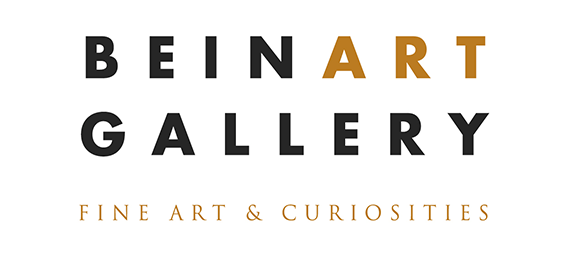 "Still in One Piece IV" from Lucid Dream series - Porcelain sculpture by Johnson Tsang
"Still in One Piece IV" from Lucid Dream series - Porcelain sculpture by Johnson Tsang
The mind-bending sculptures of Johnson Tsang push the limits of imagination and sometimes even of gravity. By turns whimsical, lyrical, and provocative, his works capture the fluidity of both physical motion and human emotion while challenging us to see the world in a different way.
"My works depicting babies were expressing my point of view to the world through the eyes of a child—my inner child." —Johnson Tsang
See available sculptures by Johnson Tsang.

Left: "Soul Shopping" & Right: "Hang in There" from Lucid Dreams series - Porcelain sculptures by Johnson Tsang.
Julie Antolick Winters: Tell us how sculpture became your preferred medium for creating art.
Johnson Tsang: I have liked observing everything around me since I was four years old. The world was so beautiful for me, especially Mother Nature. I drew as much as I could. Ten years later, people said I was very good at it. However, I wasn’t satisfied with 2D expression because everything I saw was in 3D. I could not find a way to capture the beauty of nature even though I was able to draw very realistically. Then, just like other kids, I started to play with clay. I just loved it. The difference between me and other kids is that when I found something I liked, I never wanted to stop. So, here I am.

"Open Mind" - Porcelain sculpture by Johnson Tsang.
JAW: You were a police officer for several years before you started making art full-time. Did you leave the police squad in order to devote more time to art, or did you simply find that after you left, you had more time for sculpting?
JT: I had been working in the Royal Police Force for 13 years before my resignation. It was my passion for art that led me to this crucial step. In 1991, I started to learn ceramics. I fell in love with clay immediately. I kept having ideas when I wasn’t in the pottery class. Two years later, in 1993, I decided to quit my job to explore a new life. It was this turning point that changed my life forever. Then, art changed the way I observed things happening around me.

"Dreams Come True" - Porcelain sculpture by Johnson Tsang.
JAW: How did your time on the police squad affect your artwork in terms of subject matter?
JT: At the beginning of my new life, I felt that I had wasted 13 years of time when I wasn’t exploring art. A few years ago, I started to see something hiding in my works that may have originated from the time of my service. I’d been serving in many departments in the police force—like the tactical unit, emergency unit, special duty squad, vice (anti-drug squad), and traffic accident investigation team. I’ve seen a lot of cases that needed police assistance or enforcement. Most of the time those cases showed the dark side of the city and humanity. What affected me the most were the fatal cases. I saw people being stabbed and killed by gangsters, a 6-year-old girl who was murdered by her maid, an 11-year-old girl who watched her younger brother die under a big tire of a double-decker bus while she was helping her mother to take care of him, and lots of faces of people who lost their lives in fatal car accidents. Today, I would definitely say that my service plays an important role in my creation. At least, I see things differently.

"Security Summit" - Porcelain sculptures by Johnson Tsang.
JAW Many of your pieces feature babies, often in contexts in which a person would not expect to see them. How did your work evolve to include babies?
JT: For many years, I ran a workshop for teaching pottery . In 2005, I started teaching kids: I told my inner self to go back to the age of a child. Then I became one of them, enjoying the classes. My inner child kept visiting me from time to time, especially when I created my own art. I believe that sometimes I wasn’t the one creating my works. My works depicting babies were expressing my point of view to the world through the eyes of a child—my inner child.

Photo of Johnson Tsang with his sculpture.
JAW: Would you say that there is an overarching theme in your work? What is it that you hope viewers will carry away from your pieces?
JT: There are something deep in our soul which answers all the questions and problems happening right now. That is love. I do wish to make a better world. Somehow, I couldn’t find a better way to do it, as I am not good at any other territory. Luckily, I found art. Recently, when I had a chance to look over my past works, as I prepared for a talk about my works, I discovered that I have a pattern in creation. I found that I created work related to the theme of love after I made a couple of works expressing some negative messages. It seemed like I was answering with “love” to the questions arising from my work.

"Break The Rules" - Porcelain sculptures by Johnson Tsang.
JAW: Do you start your pieces with a concept fully in mind, or do the concepts become more complete as you work through a piece?
JT: I have worked in both ways, and I enjoy both. Sometimes, a spontaneous way of creating brought a big surprise.
JAW: What do you enjoy most about the process of sculpting?
JT: I enjoy every moment in creation. I feel excited when building an idea in my mind. I find peace of mind when I touch clay. I feel satisfied when a problem is solved. I feel grateful when the mission is completed. Then, I feel that I love it more than ever. So I feel excited to start the next project.

"Oops!" - Porcelain sculpture by Johnson Tsang.
JAW: What are the most challenging aspects of making your art and getting it seen by others?
JT: I have confidence in turning a piece of clay into any form. However, there are some limitations to working as a sculptor in Hong Kong. This is one of the most expensive cities in the world. Most local artists here face the same problem of unaffordable space. Practically, it limits the size of my works. Limited space may be good for me: it means I use less time, making smaller pieces, creating more works and sharing more ideas.

"A Painful Pot" - Porcelain sculpture by Johnson Tsang.
JAW: You have worked in ceramics, stainless steel, and wood. Is there any medium for sculpture that you would like to try but have not yet?
JT: I have tried different materials for my sculpture. I did search for any possibility of using other materials, exploring new directions, wishing to create greater work. Then, a question from inside arose: “Is that what you really love?” Somehow, my answer was so clear: I love working with clay. There is love and peace in it that interacts with my subconsciousness. What else do I need?

"Yangyang" - Stainless steel sculpture by Johnson Tsang.
JAW: What did you have to learn about stainless steel before starting to work with it? Did you have any background training that made this medium a natural one for you to try, or did you decide you wanted to use it, so then you set out to learn about it?
JT: I am a self-taught artist, I learned pottery, metal work, and wood work, mostly by myself. Eight years ago, I thought of using stainless steel instead of porcelain for my splash work. Compared to porcelain, this material is much stronger. Then I spent two months learning and working with steel casting, welding and polishing in Guangzhou, China. This was a great experience. Afterwards, I created a few pieces of steel works for some public art projects.

"We Luv U Dad!" - Porcelain sculptures by Johnson Tsang.
JAW: What are your thoughts about the place of ceramic art in the current art scene?
JT: Ceramics is just one of the hundreds of art forms today. I am not interested in finding its position among the others. I fell in love with ceramic twenty-five years ago. I still love it today. It has the most important place in my creations. Romantic, isn’t it?

"Big Fish" - Porcelain sculpture by Johnson Tsang.
JAW: Do you have anything you would like to tell our readers about what you are working on now and what you have planned for the future?
JT: I am working on a couple of series right now. One of them is “Lucid Dream.” The idea came from my dreams. For years, I have written down my dreams. I turned some of these strange dreams into ideas. Sometimes, the ideas arose from meditation. As the ideas were not originated from my consciousness. I found this fascinating; after the first one was done, it felt like my dreams came true. What is my plan for the future? I would simply say that I will keep doing what I am doing right now. I spend about 50 to 60 hours a week in my work. My wish is that I can keep a healthy body and mind to persist.

Left: "Two in One" & Right: "Go Within" from Lucid Dreams series - Porcelain sculptures by Johnson Tsang.
This interview was written by Julie Antolick Winters for Beinart Gallery in 2016.
Julie Antolick Winters is a writer and editor residing in the state of Maryland, USA, in a small city near Washington, D.C. Julie cowrote the introduction for Black Magick: the Art of Chet Zar and co-copyedited this book and Kris Kuksi: Divination and Delusion for Beinart Publishing. She has also been conducting artist interviews for the Beinart Collective & Gallery since 2010. In addition to her work for the Beinart Gallery, she edits science articles and books, writes poetry and practices the art of negotiation with her son.




 Cart
Cart



